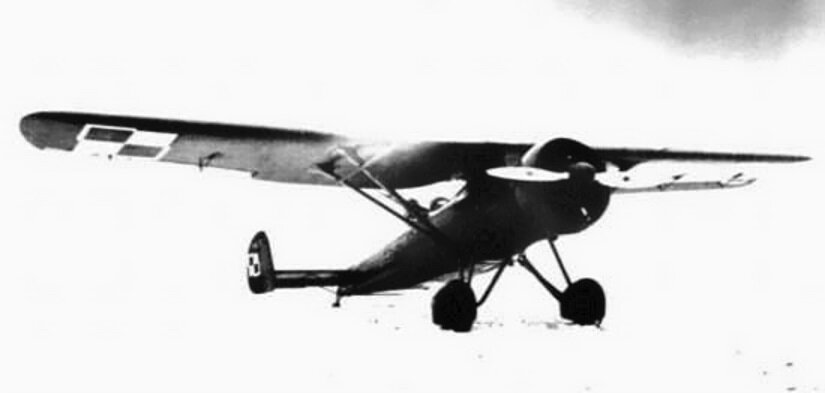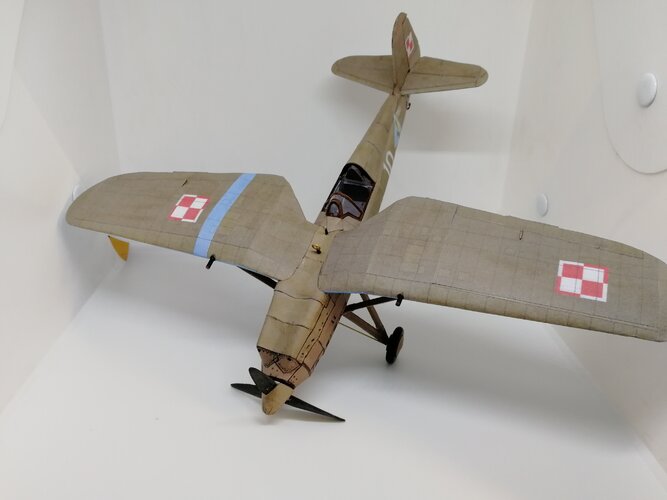Hi,
A.Glass in his books gives information about the preliminary design of the PZL P.28 fighter with an in-line engine for Yugoslavia, implemented in cooperation with the French engine manufacturer Loraine. The construction of the prototype did not take place because the Yugoslavs chose the Hawker Furry. I built a cardboard model of this fighter based on the descriptions in the mentioned books. Below is a picture of this model.
http://www.samolotypolskie.pl/samoloty/2402/126/PZL-P-28
From the beginning of the 1930s,
the State Aviation Works tried to obtain an order from the military aviation of Yugoslavia for fighter aircraft of its own design. In June 1931,
the PZL P-6 fighter aircraft was presented in Belgrade . In December 1933, a proposal was made to deliver 20
PZL P-11 fighter aircraft to Yugoslavia and to grant a license for their production. In September 1934, a squadron of eight
PZL P-7a and two
Lublin R-XIII aircraft visited Yugoslaviaunder the command of General L. Rayski. On September 12, General Rayski flew to Bucharest and Lwów, the next day the rest of the squadron left Belgrade, heading home. However, Lt. pil. Mieczysław Medwecki, who was to conduct a series of tests and demonstrations of the
PZL P-7a aircraft . Unfortunately, on September 18, 1934, these attempts ended in disaster. The plane was heavily damaged and Lt. pil. M. Medwecki wounded.
Unfortunately, the summary of the PZL P-7a tests was not very optimistic. The advantages of the Polish machine were emphasized, such as maneuverability, maneuverability, ease of piloting. Many shortcomings were also reported, e.g. insufficient speed and ceiling, poor visibility from the cabin due to the large diameter of the engine and its arrangement. The PZL P-7a aircraft had no chance for export success, so it was necessary to come up with a new, defect-free previous proposal.
In May 1935, the Yugoslav Air Command suggested offering Yugoslavia the latest
PZL P-24 fighter , equipped with the Lorraine Dietrich "Petrel" 12 HD.RS engine equipped with a compressor, with more power than the version used to drive the
P-8/II . With the new engine, the P.8 was supposed to reach a maximum speed of 400-420 km/h.
The Polish side considered the presentation of the PZL P-8/II aircraft with the "Petrel" engine in Belgrade . The aircraft was equipped with a Lorraine engine, older than the type suggested by the Yugoslav side, and in its existing condition did not meet military requirements.
Therefore, it was proposed to present PZL P-11c aircraft in Yugoslavia or to develop a project for the
PZL P-28 fighter, equipped with a Lorraine Dietrich "Petrel" engine. It was a further development of the
PZL P-8 aircraft , using assemblies from
the PZL P-24 (wings, empennage, landing gear). The design of
the PZL P-28 aircraft was developed by
Wsiewołod Jan Jakimiuk . If a potential contractor is interested, this machine could be made within six months. However, the cost of implementing the
P-28 project , which would have to be covered by the Yugoslav side, would have to be quite high. In relation to the already produced
PZL P.11c aircraft (because it is he, not
PZL P-24it was to become the basis for possible modifications) only the wings, part of the landing gear, the empennage, the pilot's seat and part of the cockpit equipment could remain without significant changes. However, they would have to be replaced, e.g. fuselage, covers, tanks, radiators, propeller. In contrast, the engine was to be supplied free of charge by
Lorraine Dietrich .
However, it was found that the performance of the PZL P-28 aircraft could not be better than that of
the PZL P-24 .
Therefore, the delivery of PZL P-11c aircraft with the French Gnôme Rhône K9 engine or the English Bristol "Mercury VI" or the
PZL P-24 fighter was offered . The Polish proposals were not accepted.
The postulate of financing the cost of making the PZL P-28 aircraft was considered impossible to meet. Ultimately, Yugoslavia did not purchase Polish fighters. Also
PZL P-28 remained only in the project. Work was stopped in 1935.
Construction :
Single-seat strutting high-wing monoplane with a metal structure.
Cabin covered.
Classic tailplane, horizontal stabilizers supported by struts.
Classic fixed landing gear.
Armament - 2 fixed 7.9 mm Vickers E machine guns in the front of the fuselage and (optionally) 2 fixed 20 mm Oerlikon cannons in the wings. Bombs - four light bombs weighing 12 kg each on the outer hooks under the wings.
Equipment - radio station, equipment for night flights.
Engine - in-line V-type Lorraine Dietrich "Petrel" 12 HD.RS with a maximum power of 570 kW (775 HP).
Technical data of the PZL P-28 (according to [3]):
Wingspan - 10.5 m, length - 7.56 m, height - 2.75 m, carrying area - 18.00 m 2 .
Curb weight - approx. 1130 kg, total weight - 1755-1816 kg.
Estimated max speed - 420 (according to [1] - 425) km/h, climb - 12 m/s, climb time to 5000 m - 6', range 750 km.






![eee4[1].jpg](/data/attachments/196/196542-b808389c8b19c1f1783a6c1be33f2cb5.jpg)














![L'Année_aéronautique___par_L_[...]_bpt6k6554010d_24.jpeg](/data/attachments/199/199327-f099a963ed007bf5ef250146ce4b5407.jpg)



























